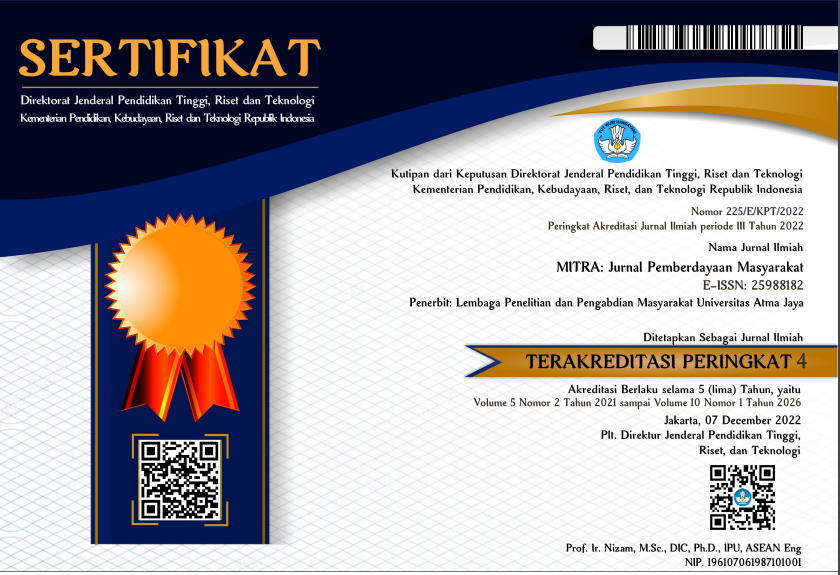Green Kampong Management Using a Participatory Community Approach
DOI:
https://doi.org/10.25170/mitra.v5i1.1793Keywords:
urban kampong; green kampong; placemaking; green communityAbstract
The urban kampong ‘kampung kota’ is an essential part of the formation of city structures. One existing urban kampong in Jakarta is kampung Tanjung Gedong, located at RT 05/RW 08, Tomang Sub-district, Grogol Petamburan District in West Jakarta. Its location, which is 500 meters from Untar Campus 1, was one consideration for selecting kampung Tanjung Gedong as a partner. The team has also carried out community service activities (PKM) in this location, and it is expected that the program implemented would be sustainable. In the context of urban life, kampung Tanjung Gedong has physical, spatial, and environmental problems, mainly due to the high level of building density. The purpose of these activities was to provide a solution for urban village management using a participatory community approach. The proposed solution is penataan Kampung Hijau ‘Green Kampong Management’ by involving community members’ active participation from the beginning of the planning to the management through the placemaking method, which involves three approaches: green planning and design, green open space, and green community. This proposed green kampong concept is expected to overcome the problems encountered by the partner in achieving a healthy and comfortable environment for residents. The concept of green kampong is a promising solution in solving the physical environmental and spatial problems of kampung kota Tanjung Gedong. The program has improved the quality of the environment and increased the community's social quality in a form of a healthier lifestyle.
References
Kusumawijaya, M. (2004). Jakarta: Metropolis tunggang langgang. Jakarta: Gagas Media.
Luky, D. F., Mulyono, G., & Basuki, L. (2017). Perancangan interior healthy food center dan taman hidroponik di Surabaya. JURNAL INTRA, 5(2), 683–692.
Mahagarmitha, R. R. (2018). Partisipasi masyarakat dalam mewujudkan kampung warnawarni Teluk Seribu Kota Balikpapan. ARTEKS, Jurnal Teknik Arsitektur, 3(1), 57. https://doi.org/10.30822/artk.v3i1.159.
Nugroho, A. C. (2009). Kampung kota sebagai sebuah titik tolak dalam membentuk urbanitas dan ruang kota berkelanjutan. Jurnal Rekayasa, 13(3), 209–218.
Program Pengembangan Kota Hijau, (P2KH). (2011). Lokakarya “Perubahan iklim dan Kota Hijau: Dari konsep menuju rencana aksi.” Direktur Perkotaan Kementerian Pekerjaan Umum Direktorat Jenderal Penataan Ruang.
Project for Public Spaces and Metropolitan Planning Council. (2008). A guide to neighborhood placemaking in Chicago. Chicago: Metropolitan Planning Council.
Setiawan, B. (2010). Kampung kota dan kota kampung: Potret tujuh kampung di Kota Jogja. Yogyakarta: Pusat Studi Lingkungan Hidup Universitas Gadjah Mada.
Setiawan, B. (2015). Kampung kota dan kota kampung: Tantangan perencanaan kota di Indonesia #1. http://kampungnesia.org/berita-kampung-kota-dan-kota-kampung--tantangan-perencanaan-kota-di-indonesia--1.html (Diakses 21 Maret 2021).
Solikhah, N., & Fatimah, T. (2019). Penataan Kampung Hijau di Rt.05/ Rw. 08, Kelurahan Tomang, Kecamatan Grogol Petamburan, Jakarta Barat. Laporan PKM (Tidak diterbitkan). Jakarta: Lembaga Penelitian dan Pengabdian kepada Masyarakat Universitas Tarumanagara.
Solikhah, N., & Fatimah, T. (2020). Kampung Hijau pada kampung kota (Studi kasus: Kampung Tanjung Gedong RT 05/ RW 08, Jakarta Barat). Jurnal Bakti Masyarakat Indonesia, 3(1), 137–147. https://doi.org/10.24912/jbmi.v3i1.7996.
Syarifa, N. H., & Wijaya, A. (2019). Partisipasi masyarakat dalam kegiatan pemberdayaan melalui program Kampung Tematik (Studi kasus di Kampung Batik Kelurahan Rejomulyo Kecamatan Semarang Timur Kota Semarang). Solidarity: Journal of Education, Society and Culture, 8(1), 515–531.
Yuliastuti, N., & Sukmawati, A. M. (2020). Creative urban kampung based on local culture, A case of kampung Bustaman Semarang. Journal of Architecture and Urbanism, 44(2), 128–137. https://doi.org/10.3846/jau.2020.11450
Downloads
Published
Issue
Section
License
This license allows reusers to distribute, remix, adapt, and build upon the material in any medium or format for noncommercial purposes only, and only so long as attribution is given to the creator. If you remix, adapt, or build upon the material, you must license the modified material under identical terms.



_.jpeg)

.png)
2.png)
.png)
.png)



